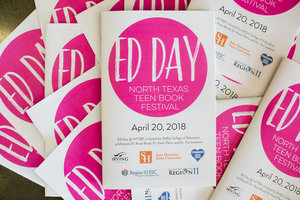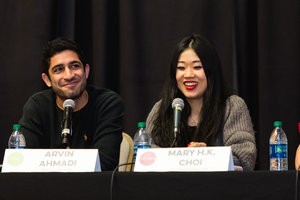Stars of YA Fiction Head To Irving Saturday
ArtandSeek.net March 22, 2019 30On Saturday, Irving will become the center of the teen fiction universe. The North Texas Teen Book Festival kicks off, bringing 70 to 80 authors from around the country, including best-sellers and award-winners such as Tomi Adeyemi (“Children of Blood and Bone”), Elizabeth Acevedo (“Poet X”), Tahereh Mafi (“Shatter Me” series), Angie Thomas (“The Hate U Give”) and Ibi Zoboi (“Black Enough”).
The festival focuses on young adult fiction (YA) and middle grade authors. YA is notable for the way it tackles serious topics, like immigration, racism, sexism and sexual assault, in an honest way.
The YA fiction industry and fan base is enormous and very active on the Internet. More and more film adaptations are based on YA novels, like Angie Thomas’ “The Hate U Give” and Tahereh Mafi’s “Shatter Me.” Fort Worth’s own best-seller, Julie Murphy, whose novel “Dumplin’” is now a Netflix movie, will also be at the festival.
Behind the scenes, a team of visionary organizers and volunteers work hard to bring this massive festival to reality. Admission is free. Funding for the festival comes from the city of Irving and from corporate sponsorship.
Now in its fifth year, the festival was the brainchild of Dr. Rose Brock, of Sam Houston State University, and Kristin Treviño, of the Irving Public Library system.
It all started when Irving Public Library system began holding author visits. The turnout was overwhelming; clearly teens wanted more authors to visit North Texas. From there, Treviño thought of holding a festival and spearheaded the initiative with Brock. In addition to Saturday’s festival, about 500 educators were expected to attend “Ed Day” on Friday. They’ll discuss curriculum building, classroom culture, and YA.
What sets North Texas apart is the demographics of our attendees. We are 80 percent teens and 20 percent adults, and that’s kind of the flip of other big teen festivals.
NTTBF’s Evolution
NTTBF has grown significantly since its inaugural festival in 2015, with 53 authors. Treviño and Brock said they’d be grateful if 500 attendees showed up. About 3,500 people attended.
“Year two was the growing pain year, where we shot up to like 8,000 [attendees]. And that was the year that was the hardest, because we just weren’t expecting that. And years three and four, we were refining how to manage that many people,” Treviño said.
Organizers start out with a wish-list of around 200 authors. They narrow it down to about 70, balancing popular authors with new talent. They also look for diversity, so readers see themselves in the stories discussed at NTTBF.
“We’re thinking about our own personal communities, but also our outreach spans [far.] We have teachers and community members who are hours and hours away who get up at the crack of dawn,” Brock said. “We have schools that leave in 3 in the morning to get on school buses to come here, which really speaks to those people in those communities you know who are part of North Texas. Sometimes even further; we’ve had schools that have come from Arkansas.”
Brock and Treviño enjoy hearing from attendees. They receive a lot of heartfelt letters. Kids say they met their new best friend or a new reading friend at the festival.
“Every year we have our ‘endless stories’ wall,” Treviño said. “It’s like ‘endless stories, tell us yours.’ And just little pieces of paper, and you can tell by the handwriting that they’re mostly kids. They will tell you what authors they want to ‘we don’t want any hot dogs [in the cafe]’ to very personal, deep stories. And you’re just like, ‘wow.’ Every year when you’re just so tired and read those, and you’re like ‘this is why we do it.’”
Meet the NTTBF founders, Dr. Rose Brock and Kristin Treviño, and learn about the work behind educator and festival day.
What’s your thought process behind developing Ed day?

Last year’s Edudcator (Ed) Day programs, photo courtesy of NTTBF.
“We talk about kids not being engaged in reading- sometimes it’s just what they’re being asked to read is boring. Or it doesn’t fit anymore. There may have been a time for that, but we have to let books retire.”
It’s a very rare thing where a teacher can go to a NCTE, which is the National Council of Teachers of English. In a school district, only one person goes, or one or two. Certainly not an entire staff, and every school has an entire English department or ELA department. So, and at those kinds of national conferences, these very things happen. But, again, very few people are getting to see that.
There is no entrance fee– not for adults, and certainly not for kids. How do you maintain that level accessibility for such a large festival?

Image of Mary HK Choi, author of the bestselling book “Emergency Contact” and the culture correspondent for Vice News Tonight, and Arvin Ahmadi, debut author of “Down and Across.” Photo courtesy of NTTBF.
We’ve even had coordinators of other big YA festivals nationwide ask us. That is another thing I’ve been told, because I have not really been to the other ones, what sets North Texas apart is the demographics of our attendees. We are 80 percent teens and 20 percent adults, and that’s kind of the flip of other big teen festivals. Publishers have told us that they don’t see teens come out en masse. And we’ve had other organizers of big huge festivals say, ‘How do you get the teens? How do you get all these buses to come here? We even pay for buses!’ We don’t pay for buses. We don’t pay for a single bus to come. It’s literally the North Texas [community.] It is the teachers, the librarians. We can have this all set up and pretty, but it’s everyone bringing the kids here. It’s a community effort.










